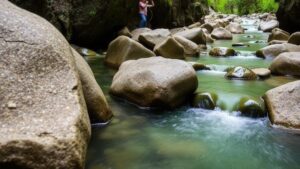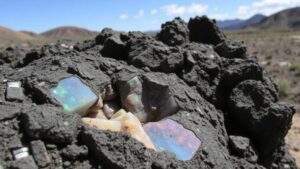Excavating ancient clamshell fossils in the deserts of Saudi Arabia, remnants of prehistoric seas.
Excavating Ancient Clamshell Fossils in Saudi Arabia
Saudi Arabia, known for its vast deserts and rich petroleum reserves, also houses a treasure trove of prehistoric marine fossils, particularly clamshell fossils. These remnants tell the story of ancient seas that once covered the Arabian Peninsula millions of years ago. For rockhounds and mineral collectors, the expedition into these arid landscapes not only provides a unique collecting opportunity but also a rare glimpse into the Earth’s geological history.
The Geological Background
During the Late Cretaceous period, approximately 100 to 66 million years ago, the area now known as Saudi Arabia was submerged under the Tethys Sea. This shallow, warm sea was home to a diverse range of marine life, including bivalves such as clams. Fossils of these organisms can be found embedded in sedimentary rock formations throughout the desert regions.
The formation that features these fossils is primarily composed of limestone and chalk, which have been etched out by the forces of weathering and erosion. Notable locations for fossil hunting include the Eastern Province and the central region of Najd, where stratified rock layers reveal a vivid historical record.
Importance of Clamshell Fossils
Clamshell fossils serve as significant indicators of prehistoric environments. By studying these fossils, paleontologists can infer information about:
- The biodiversity of ancient ecosystems.
- Environmental conditions such as water depth and temperature.
- Geological changes that have occurred over millions of years.
For rockhounds, collecting these fossils can enhance their collections with pieces that boast not only aesthetic value but also educational significance. For example, the presence of specific clamshells can point to corresponding sediment types, revealing past climate conditions.
Practical Tips for Collectors
If you are considering a fossil-hunting expedition in Saudi Arabia, here are several practical tips to ensure a successful and safe endeavor:
- Research Locations: Before embarking on your journey, familiarize yourself with areas known for fossil finds. Online forums and dedicated fossil hunting communities can offer valuable insights and personal experiences.
- Obtain Permissions: Some areas may require permits or have restrictions on fossil collection. Always check local regulations and get the necessary permissions to avoid legal issues.
- Bring the Right Tools: Essential tools include a rock hammer, chisels, safety goggles, and a sturdy backpack. A geological map of the area can also be beneficial.
- Practice Safe Exploration: Stay hydrated, protect yourself from the sun with appropriate clothing and sunscreen, and never venture alone in remote areas.
- Document Your Finds: Take detailed notes and photographs of your collection sites. This information can be invaluable for future reference and for sharing with fellow enthusiasts.
Real-World Applications
The excavation and collection of clamshell fossils in Saudi Arabia are not simply recreational activities. contribute to a broader understanding of paleobiology and geology, which can have applications in various fields, including:
- Paleontology: Provides insights into evolutionary biology and the history of life on Earth.
- Geology: Helps in reconstructing past environments and contributes to oil exploration efforts.
- Education: Fossils serve as tangible examples for teaching geology and paleontology in academic settings.
Conclusion
Excavating ancient clamshell fossils in the deserts of Saudi Arabia presents an exciting opportunity for rockhounds and mineral collectors alike. By understanding the geological context, importance, and best practices for fossil hunting, collectors can enhance their experiences while contributing to the understanding of our planet’s history. With the right preparation, your fossil-hunting adventure can yield remarkable discoveries that bridge the past with our present, enriching both personal collections and the scientific community.



